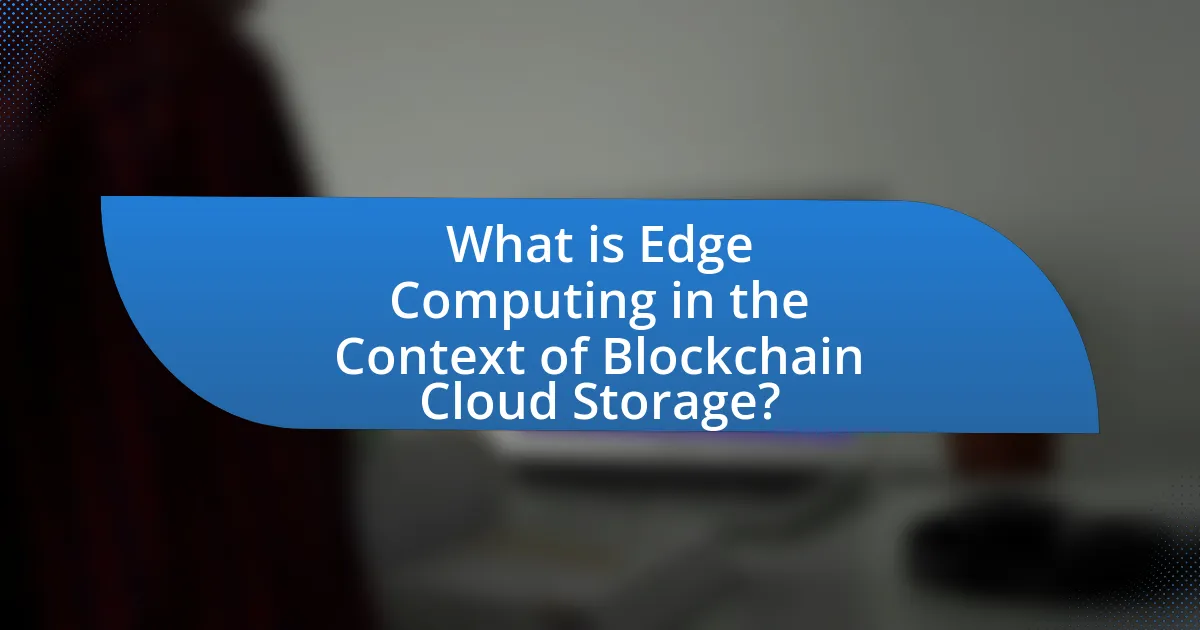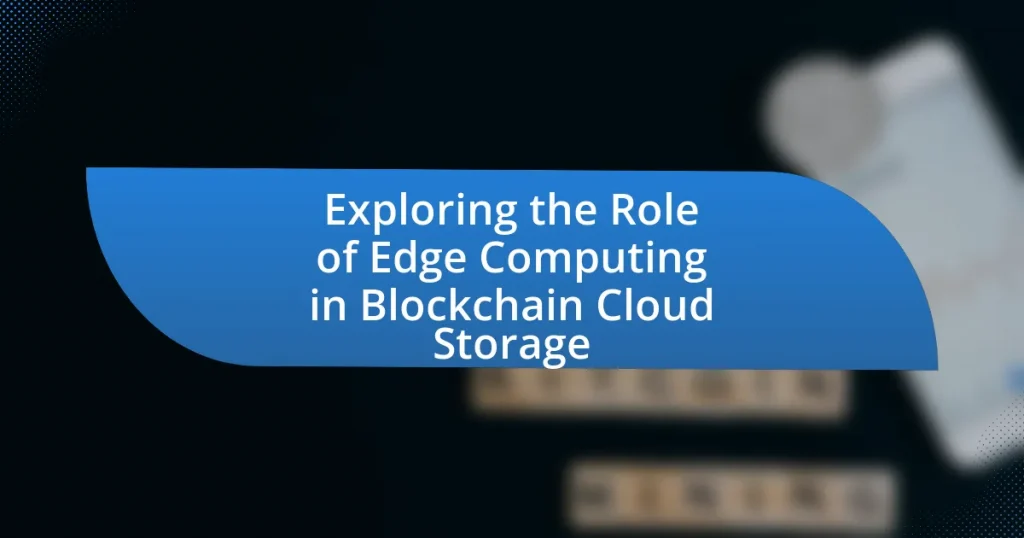Edge computing plays a crucial role in enhancing blockchain cloud storage by enabling decentralized data processing closer to the data source. This integration significantly reduces latency, improves data processing efficiency, and enhances security, making it essential for real-time applications such as IoT and financial transactions. The article explores how edge computing addresses challenges faced by traditional cloud storage, including bandwidth limitations and data privacy concerns, while also discussing its benefits in various industries. Additionally, it highlights potential limitations and technical challenges, as well as future trends and best practices for organizations implementing these technologies.

What is Edge Computing in the Context of Blockchain Cloud Storage?
Edge computing in the context of blockchain cloud storage refers to the decentralized processing of data at the edge of the network, closer to the data source, rather than relying solely on centralized cloud servers. This approach enhances data processing speed and reduces latency, which is critical for applications requiring real-time data access and transaction verification in blockchain systems. By distributing data storage and processing across multiple edge nodes, edge computing also improves security and resilience, as it minimizes the risk of a single point of failure. Studies indicate that integrating edge computing with blockchain can lead to more efficient resource utilization and improved scalability, making it a vital component in modern cloud storage solutions.
How does Edge Computing enhance Blockchain Cloud Storage?
Edge Computing enhances Blockchain Cloud Storage by reducing latency and improving data processing efficiency. By processing data closer to the source, Edge Computing minimizes the time it takes for data to travel to centralized cloud servers, which is crucial for real-time applications. This proximity allows for faster transaction verification and data retrieval on the blockchain, leading to improved user experiences. Additionally, Edge Computing can distribute the storage load across multiple nodes, enhancing scalability and resilience of the blockchain network. This decentralized approach aligns with the fundamental principles of blockchain, ensuring that data remains secure and accessible while reducing the risk of bottlenecks associated with centralized cloud storage solutions.
What are the key features of Edge Computing that benefit Blockchain Cloud Storage?
Edge Computing enhances Blockchain Cloud Storage through reduced latency, improved data processing efficiency, enhanced security, and increased scalability. Reduced latency occurs as data is processed closer to the source, minimizing delays in transactions and data retrieval. Improved data processing efficiency is achieved by offloading tasks from centralized servers to edge devices, allowing for faster and more efficient handling of blockchain transactions. Enhanced security is provided by decentralized data storage, which limits the risk of single points of failure and potential attacks. Increased scalability is facilitated by the ability to add more edge devices to the network, accommodating growing data demands without overloading central servers. These features collectively optimize the performance and reliability of Blockchain Cloud Storage systems.
How does data processing at the edge improve efficiency in Blockchain Cloud Storage?
Data processing at the edge improves efficiency in Blockchain Cloud Storage by reducing latency and bandwidth usage. By processing data closer to the source, edge computing minimizes the time it takes for data to travel to centralized servers, which is crucial for real-time applications. This localized processing allows for quicker validation and storage of transactions on the blockchain, enhancing overall system performance. Additionally, edge computing decreases the amount of data that needs to be transmitted over the network, leading to lower bandwidth costs and reduced congestion. This efficiency is supported by studies indicating that edge computing can cut latency by up to 50% and reduce bandwidth usage by 30%, thereby optimizing the operational capabilities of Blockchain Cloud Storage systems.
Why is the integration of Edge Computing and Blockchain Cloud Storage important?
The integration of Edge Computing and Blockchain Cloud Storage is important because it enhances data processing efficiency and security. Edge Computing allows data to be processed closer to the source, reducing latency and bandwidth usage, while Blockchain provides a decentralized and immutable ledger for secure data storage and transactions. This combination ensures that sensitive data is handled swiftly and securely, which is crucial for applications requiring real-time processing and trust, such as IoT devices and financial transactions. Furthermore, studies indicate that this integration can lead to improved scalability and resilience in data management systems, making it a vital development in modern technology infrastructure.
What challenges does traditional cloud storage face that Edge Computing addresses?
Traditional cloud storage faces challenges such as latency, bandwidth limitations, and data privacy concerns, which edge computing effectively addresses. Latency in traditional cloud storage arises from the distance data must travel to centralized data centers, leading to delays in data access and processing. Edge computing mitigates this by processing data closer to the source, significantly reducing response times. Bandwidth limitations occur when large volumes of data are transmitted to and from centralized servers, often resulting in congestion and slower performance. Edge computing alleviates this by enabling local data processing, thus minimizing the amount of data that needs to be sent over the network. Additionally, data privacy concerns are heightened in traditional cloud storage due to centralized data repositories that can be vulnerable to breaches. Edge computing enhances data security by keeping sensitive information closer to the user and reducing the risk of exposure during transmission.
How does the combination of these technologies enhance data security?
The combination of edge computing and blockchain technology enhances data security by decentralizing data storage and processing, which reduces the risk of single points of failure. Edge computing processes data closer to the source, minimizing latency and potential exposure to cyber threats during data transmission. Blockchain technology adds an immutable ledger that ensures data integrity and transparency, making unauthorized alterations easily detectable. Together, these technologies create a robust security framework; for instance, a study by IBM found that organizations using edge computing with blockchain reported a 30% reduction in data breaches compared to traditional cloud storage solutions.

What are the Use Cases of Edge Computing in Blockchain Cloud Storage?
Edge computing enhances blockchain cloud storage by enabling decentralized data processing closer to the data source, which improves efficiency and reduces latency. Use cases include real-time data analytics, where edge devices process data locally before sending it to the blockchain, thus minimizing delays. Another use case is in IoT applications, where edge computing allows for secure and efficient data storage and retrieval from blockchain networks, ensuring data integrity and reducing bandwidth usage. Additionally, edge computing supports enhanced security measures by allowing sensitive data to be processed locally, thereby limiting exposure to potential breaches during data transmission. These use cases demonstrate how integrating edge computing with blockchain cloud storage can optimize performance and security in various applications.
How is Edge Computing applied in real-world Blockchain Cloud Storage scenarios?
Edge computing enhances blockchain cloud storage by processing data closer to the source, reducing latency and bandwidth usage. In real-world scenarios, this is evident in decentralized applications (dApps) that utilize edge nodes to store and retrieve data efficiently, ensuring faster transaction times and improved user experiences. For instance, companies like Filecoin leverage edge computing to allow users to store files on distributed nodes, which optimizes data retrieval speeds and enhances security through decentralized storage. This approach not only improves performance but also aligns with blockchain’s principles of decentralization and data integrity.
What industries are leveraging Edge Computing with Blockchain Cloud Storage?
The industries leveraging Edge Computing with Blockchain Cloud Storage include healthcare, finance, supply chain management, and smart cities. In healthcare, Edge Computing enhances data processing for patient monitoring systems while Blockchain ensures secure patient data management. The finance sector utilizes these technologies for real-time transaction processing and fraud prevention, with Blockchain providing transparency and security. Supply chain management benefits from improved data integrity and traceability, as Edge Computing facilitates real-time data collection and Blockchain secures the data. Smart cities employ these technologies for efficient resource management and secure data sharing among various services.
How do specific applications benefit from this integration?
Specific applications benefit from the integration of edge computing and blockchain cloud storage by achieving enhanced data processing speed and improved security. Edge computing allows data to be processed closer to the source, reducing latency and enabling real-time analytics, which is crucial for applications like IoT devices and smart cities. Additionally, the decentralized nature of blockchain enhances data integrity and security, making it ideal for applications in finance and healthcare where data protection is paramount. For instance, a study by IBM indicates that edge computing can reduce data transmission costs by up to 30%, while blockchain technology can provide an immutable record of transactions, thereby increasing trust and transparency in applications that require secure data sharing.
What are the potential limitations of using Edge Computing in Blockchain Cloud Storage?
The potential limitations of using Edge Computing in Blockchain Cloud Storage include issues related to data security, latency, and interoperability. Data security can be compromised due to the distributed nature of edge devices, which may not have uniform security protocols, making them vulnerable to attacks. Latency can arise from the need for real-time data processing and synchronization between edge nodes and the blockchain, potentially affecting transaction speeds. Additionally, interoperability challenges exist as different edge computing platforms may not seamlessly integrate with various blockchain protocols, hindering effective data sharing and collaboration. These limitations highlight the complexities involved in implementing edge computing within blockchain cloud storage systems.
What technical challenges arise when implementing Edge Computing?
Implementing Edge Computing presents several technical challenges, including data security, network reliability, and resource management. Data security is critical as edge devices often handle sensitive information, making them vulnerable to cyberattacks; a report by the Cybersecurity & Infrastructure Security Agency highlights that 70% of organizations experienced an increase in cyber threats with edge deployments. Network reliability is another challenge, as edge computing relies on stable connections between devices and centralized systems; disruptions can lead to data loss or degraded performance. Additionally, resource management becomes complex due to the need for efficient allocation of limited computational resources across numerous edge devices, as indicated by research from the IEEE on resource optimization in edge environments. These challenges necessitate robust strategies to ensure secure, reliable, and efficient edge computing implementations.
How can these limitations be mitigated in practice?
Limitations in blockchain cloud storage can be mitigated in practice by implementing hybrid architectures that combine edge computing with traditional cloud solutions. This approach enhances data processing speed and reduces latency, as edge devices can handle data locally before sending it to the cloud, thereby minimizing bandwidth usage. For instance, a study by Zhang et al. (2020) in the journal “IEEE Transactions on Cloud Computing” demonstrates that integrating edge computing with blockchain can improve transaction throughput by up to 30%, addressing scalability issues. Additionally, employing decentralized storage protocols can enhance data security and redundancy, as data is distributed across multiple nodes, reducing the risk of single points of failure.

What Future Trends Can We Expect in Edge Computing and Blockchain Cloud Storage?
Future trends in edge computing and blockchain cloud storage include increased integration of artificial intelligence for data processing, enhanced security protocols leveraging blockchain’s decentralized nature, and the rise of hybrid cloud models that combine edge and centralized storage solutions. The integration of AI will enable real-time data analytics at the edge, improving decision-making processes. Enhanced security measures will address vulnerabilities in data transmission and storage, as blockchain technology provides immutable records and transparency. Additionally, hybrid cloud models will allow organizations to optimize performance and cost by distributing workloads between edge devices and centralized cloud services, as evidenced by the growing adoption of such architectures in industries like healthcare and finance.
How will advancements in technology shape the future of these integrations?
Advancements in technology will enhance the integration of edge computing and blockchain cloud storage by improving data processing speed, security, and scalability. For instance, the deployment of 5G networks will facilitate faster data transfer between edge devices and cloud storage, enabling real-time processing and reducing latency. Additionally, innovations in cryptographic techniques will bolster the security of data transactions on blockchain platforms, ensuring that sensitive information remains protected during transfers. Furthermore, the increasing adoption of artificial intelligence and machine learning will optimize resource allocation and data management in edge computing environments, allowing for more efficient use of cloud storage resources. These technological advancements collectively drive the evolution of integrated systems, making them more robust and capable of handling complex applications in various industries.
What emerging technologies could further enhance Edge Computing and Blockchain Cloud Storage?
Emerging technologies that could further enhance Edge Computing and Blockchain Cloud Storage include Artificial Intelligence (AI), 5G networks, and the Internet of Things (IoT). AI can optimize data processing at the edge, enabling faster decision-making and reducing latency, which is crucial for real-time applications. 5G networks provide high-speed connectivity and low latency, facilitating seamless data transfer between edge devices and blockchain networks. IoT devices generate vast amounts of data that can be efficiently processed and stored using edge computing, while blockchain ensures data integrity and security. These technologies collectively improve the efficiency, scalability, and security of Edge Computing and Blockchain Cloud Storage systems.
How might regulatory changes impact the adoption of these technologies?
Regulatory changes can significantly impact the adoption of edge computing in blockchain cloud storage by either facilitating or hindering its implementation. For instance, favorable regulations that promote data privacy and security can encourage organizations to adopt these technologies, as they align with compliance requirements. Conversely, stringent regulations that impose heavy compliance burdens or restrict data usage may deter companies from integrating edge computing and blockchain solutions. Historical examples include the General Data Protection Regulation (GDPR) in Europe, which has influenced how companies manage data storage and processing, thereby affecting the adoption rates of cloud technologies.
What best practices should organizations follow when implementing Edge Computing in Blockchain Cloud Storage?
Organizations should prioritize data security, efficient resource management, and interoperability when implementing Edge Computing in Blockchain Cloud Storage. Ensuring robust encryption and access controls protects sensitive data at the edge, while efficient resource management optimizes performance and reduces latency by processing data closer to the source. Additionally, fostering interoperability between different blockchain platforms and edge devices enhances system flexibility and scalability. These practices are supported by industry standards and frameworks, such as the NIST Cybersecurity Framework, which emphasizes the importance of security and resource efficiency in cloud computing environments.
How can organizations ensure data integrity and security in this setup?
Organizations can ensure data integrity and security in edge computing and blockchain cloud storage by implementing robust encryption methods, access controls, and regular audits. Encryption protects data both at rest and in transit, making it unreadable to unauthorized users. Access controls limit data access to authorized personnel only, reducing the risk of data breaches. Regular audits help identify vulnerabilities and ensure compliance with security standards. According to a 2021 study by the International Journal of Information Management, organizations that employ these strategies experience a 30% reduction in data breaches compared to those that do not.
What strategies can optimize performance and scalability in Edge Computing applications?
To optimize performance and scalability in Edge Computing applications, implementing data processing at the edge, utilizing efficient resource allocation, and employing adaptive load balancing are essential strategies. Data processing at the edge reduces latency by minimizing the distance data must travel, which is crucial for real-time applications. Efficient resource allocation ensures that computational resources are utilized effectively, allowing for dynamic scaling based on demand. Adaptive load balancing distributes workloads evenly across edge devices, preventing bottlenecks and enhancing overall system responsiveness. These strategies collectively enhance the efficiency and scalability of Edge Computing applications, as evidenced by studies showing reduced latency and improved throughput in edge-optimized systems.


